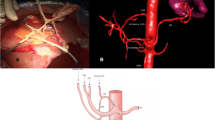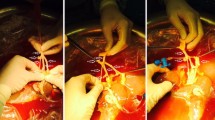Abstract
To perform hepatic surgery a precise preoperative and intraoperative study of liver vascular supply is mandatory. Detecting vascular variations may have great importance on surgical strategy and outcome, and details of anatomy do not concern only academical knowledge but become deeply involved in practice. We present a case of unusual blood supply to the liver, the common hepatic artery was directed to the right liver and a right hepatic artery originating from the superior mesenteric artery was directed to the left liver. The right hepatic artery crossed the common hepatic artery in the proximal part of the hepatic pedicle, anterior to the portal vein. To our knowledge this type of anatomical variation has not been described before and it represents a rare finding that has to be kept in mind, especially in case of major hepatectomies and more demanding splitting liver procedures such as A.L.P.P.S., in situ split, ex situ split and living donor liver transplantation.
Similar content being viewed by others
Avoid common mistakes on your manuscript.
Introduction
At present, to perform hepatic surgery a precise preoperative and intraoperative study of liver vascular supply has to be considered mandatory. In fact, detecting vascular variations may have great importance on surgical strategy and outcome, and details of anatomy do not concern only academical knowledge but become deeply involved in practice. Anatomical variations of hepatic arterial blood supply are well known and they have been extensively described in the literature [1–3, 5, 7, 9]. Modal anatomy is usually characterized by a common hepatic artery originating from the celiac trunk, but in 12–19 % of patients, the right hepatic artery originates from the superior mesenteric artery, usually directed to the right liver [4]. In less than 2 % of cases the entire hepatic artery may arise from the superior mesenteric artery. These anatomical variations deeply influence surgical strategy.
Case report
We present a case of unusual blood supply of the liver; during the preoperative evaluation of a patient affected by colorectal liver metastasis of the right lobe (segment 4, 5, 6, 7, 8) an unusual arterial supply of the liver on the arterial phase of the abdominal computed tomography (CT) was observed. A double supply was present, the common hepatic artery, originating from the celiac trunk, was directed to the right liver (s5, s6, s7, s8) (Fig. 1c). A right hepatic artery originating from the superior mesenteric artery that was directed to the left liver (s2, s3, s4) was also present. The right hepatic artery crossed the common hepatic artery in the proximal part of the hepatic pedicle, anterior to the portal vein (Fig. 1a–c). Considering the left lobe future remnant liver the operation planned was a two-stage hepatectomy performing the Associating Liver Partition and Portal vein ligation for Staged hepatectomy (A.L.P.P.S). During dissection of the hepatic pedicle the radiological findings were confirmed, and in the post-operative CT scan (Fig. 1d) it was clearly evident that the common hepatic artery stump was crossed by the right hepatic artery in the mentioned region.
Arterial phase of CT scan: a origin of the right hepatic artery from the superior mesenteric artery (arrow); b crossing of the right hepatic artery and common hepatic artery (arrow), transversal plane; c crossing of the right hepatic artery and common hepatic artery, frontal plane; d post-operative CT scan, crossing of the right hepatic artery and common hepatic artery stump (arrow), frontal plane
Discussion
To our knowledge this type of anatomical variation has not been described before and it represents a rare finding that has to be kept in mind, especially in case of major hepatectomies and more demanding splitting liver procedures such as A.L.P.P.S. [6], in situ split, ex situ split and living donor liver transplantation [8].
Conclusions
Precise preoperative evaluation of liver blood supply has great importance on surgical strategy and outcome. Details of anatomy do not concern only academical knowledge but are deeply involved in practice.
References
Matusz P (2011) Right/left symmetry of the intrahepatic distribution and terminology of the hepatic artery proper and the intrahepatic bile duct system: proposals to revise the Terminologia Anatomica. Surg Radiol Anat 33:71–74
Michels NA (1966) Newer anatomy of the liver and its variant blood supply and collateral circulation. Am J Surg 112:337–347
Okada Y, Nishi N, Matsuo Y et al (2010) The common hepatic artery arising from the left gastric artery. Surg Radiol Anat 32:703–705
Polguj M, Gabryniak T, Topol M (2010) The right accessory hepatic artery; a case report and review of the literature. Surg Radiol Anat 32:175–179
Saba L, Mallarini G (2011) Anatomic variations of arterial liver vascularization: an analysis by using MDCTA. Surg Radiol Anat 33:559–568
Schnitzbauer AA, Lang SA, Goessmann H et al (2012) Right portal vein ligation combined with in situ splitting induces rapid left lateral liver lobe hypertrophy enabling 2-staged extended right hepatic resection in small-for-size settings. Ann Surg 255:405–414
Schwarz L, Huet E, Yzet T et al (2014) An extremely uncommon variant of left hepatic artery arising from the superior mesenteric artery. Surg Radiol Anat 36:91–94
Takatsuki M, Chiang YC, Lin TS et al (2006) Anatomical and technical aspects of hepatic artery reconstruction in living donor liver transplantation. Surgery 140:824–828
Wang MJ, Cheng Z, Wang R et al (2010) Unusual course of the common hepatic artery originating from the celiac trunk. Surg Radiol Anat 32:883–885
Author information
Authors and Affiliations
Corresponding author
Ethics declarations
Conflict of interest
The authors declare that they have no conflict of interest.
Rights and permissions
About this article
Cite this article
Felli, E., Vennarecci, G., Santoro, R. et al. Right hepatic artery crossing the common hepatic artery: an unusual blood supply to the liver. Surg Radiol Anat 38, 359–360 (2016). https://doi.org/10.1007/s00276-015-1522-8
Received:
Accepted:
Published:
Issue Date:
DOI: https://doi.org/10.1007/s00276-015-1522-8





